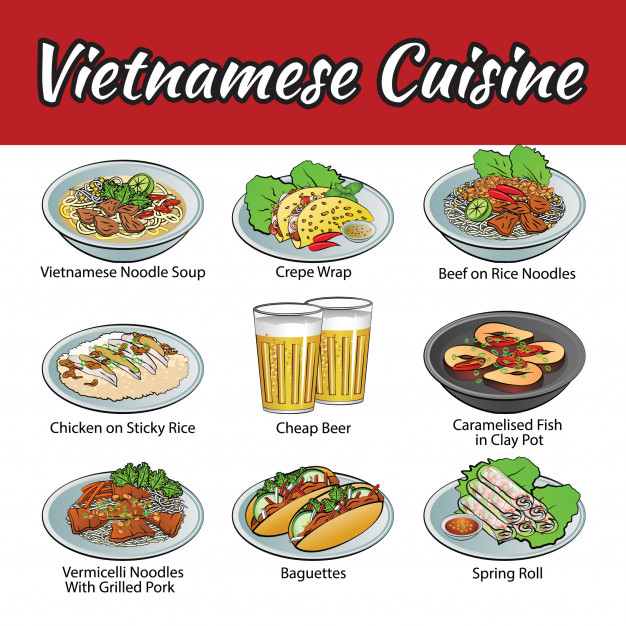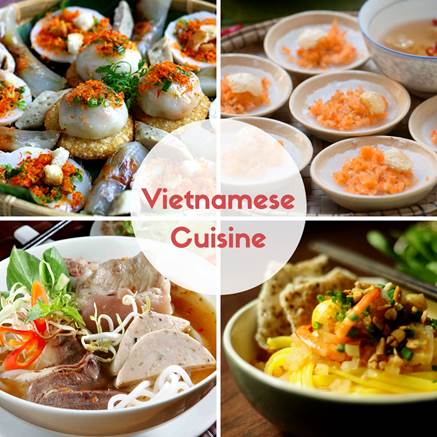Becoming increasingly famous worldwide, Vietnamese cuisine is loaded with flavor and quality that makes the food delicious in every bite. Dependent heavily on rice grown in paddy fields, each dish vary from simple meals to
Becoming increasingly famous worldwide, Vietnamese cuisine is loaded with flavor and quality that makes the food delicious in every bite. Dependent heavily on rice grown in paddy fields, each dish vary from simple meals to gourmet dishes that are designed for the king. With a balance between fresh herbs and meats, there is usually a selective use of spices to reach a fine taste. It is no wonder, it is one of the healthiest cuisine in the world.
Vietnam’s ingredients reflect the country’s geography and climate. Rice (grown in water fields throughout the country) is the main starch used in daily meals and is also incorporated into various cakes and noodles. In addition to some vegetarian Buddhist dishes, most Vietnamese dishes or meals consist of various vegetables, herbs, and meat.
Commonly used herbs are lemongrass, lime, or kaffir spice. Popular meats include pork, beef, chicken, shrimp, and various types of fish. Lamb, duck, birds, and even dogs or other wild animals are also used, but not on a large scale. Fish and soy sauces are used as seasonings and dips for almost every dish. Peanuts are also widely used in Vietnamese cuisine.

Style of Cooking
The Vietnamese cook their food in a variety of ways: frying, stir-frying, boiling, steaming. Unlike the Chinese, the Vietnamese use a minimal amount of oil during cooking. Vietnamese cooks strive to preserve the freshness and natural flavor of food as much as possible.
Regional Variations for the Cuisine
The common culinary traditions in the three regions of Vietnam share some fundamental characteristics:
- The freshness of food: Most meat is cooked only briefly. Vegetables are eaten fresh by cooking them, they are boiled or stir-fried only briefly.
- Presence of herbs and vegetables: There are herbs and vegetables that are important to many Vietnamese dishes and are often used abundantly.
- The variety and harmony of textures: Crisp with soft, watery with crunchy, delicate with rough.
- Bouillons or soup-based dishes are common in all three regions.
- Presentation: The spices in Vietnamese meals are usually colorful and arranged in an eye-catching manner.

Although they share some main characteristics, Vietnamese culinary tradition varies regionally.
In northern Vietnam, the colder climate limits the production and availability of spices. As a result, dishes are often less spicy than those in other regions. The use of black pepper in place of chilies as the most popular ingredient to produce spicy flavors. North Vietnamese cuisine is not distinctly sweet, salty, spicy, bitter, or sour. Most North Vietnamese dishes have a light and balanced flavor resulting from subtle combinations of many different flavorings. The use of meat such as pork, beef, and chicken has been relatively limited in the past. Freshwater fish, crustaceans, and mollusks, such as shrimp, squid, prawns, crabs, clams, and mussels, are widely used. Many notable dishes from northern Vietnam focus on crab (e.g., bún riêu). Fish sauce, soy sauce, shrimp sauce, and lime are among the main flavorings. Northern Vietnam has many signature dishes of Vietnam, like bún riêu and bánh cuốn, which were transferred to central and southern Vietnam by the Vietnamese migration. Other famous Vietnamese dishes originating from the north, particularly from Hanoi, are “bún chả” (rice noodle with grilled marinated pork), phở gà (rice noodle with chicken), chả cá Lã Vọng (rice noodle with grilled fish).
The abundance of spices produced by the mountainous terrain of Central Vietnam makes this region’s cuisine remarkably spicy, distinguishing it from the other two regions of Vietnam where the food is usually not spicy. Huế was once the capital of Vietnam’s last dynasty, and its culinary tradition is characterized by highly decorative and colorful dishes, reflecting the influence of ancient Vietnamese royal cuisine. The region’s cuisine is also known for its refined meals consisting of many elaborate dishes that is served in small portions. Chili peppers and shrimp sauces are the most common used ingredients. Some signature Vietnamese dishes prepared in Central Vietnam are bún bò Huế and bánh khoái.
South Vietnam’s warm weather and fertile soil are ideal for growing a wide variety of fruits, vegetables, and livestock. As a result, the food in South Vietnam is often vibrant and flavorful, with excessive use of shallots, garlic, and other fresh herbs. Sometimes, sugar is added to food more than in the other regions. The preference for sweetness in South Vietnam is also evident in the widespread use of coconut milk in South Vietnamese cuisine. Vast coastlines make seafood a natural staple food for the people of this region. Some signature seafood dishes from South Vietnam are bánh khọt and bún mắm.
In the next part of this blog, we will talk about the best underrated dishes from the Vietnamese cuisine!

